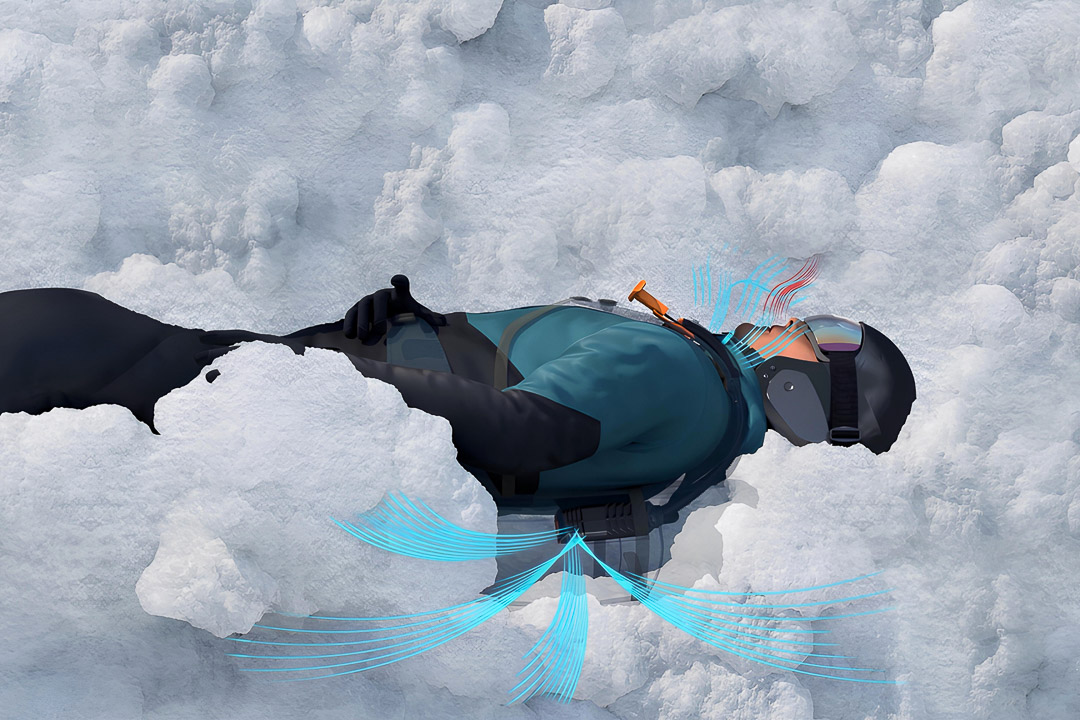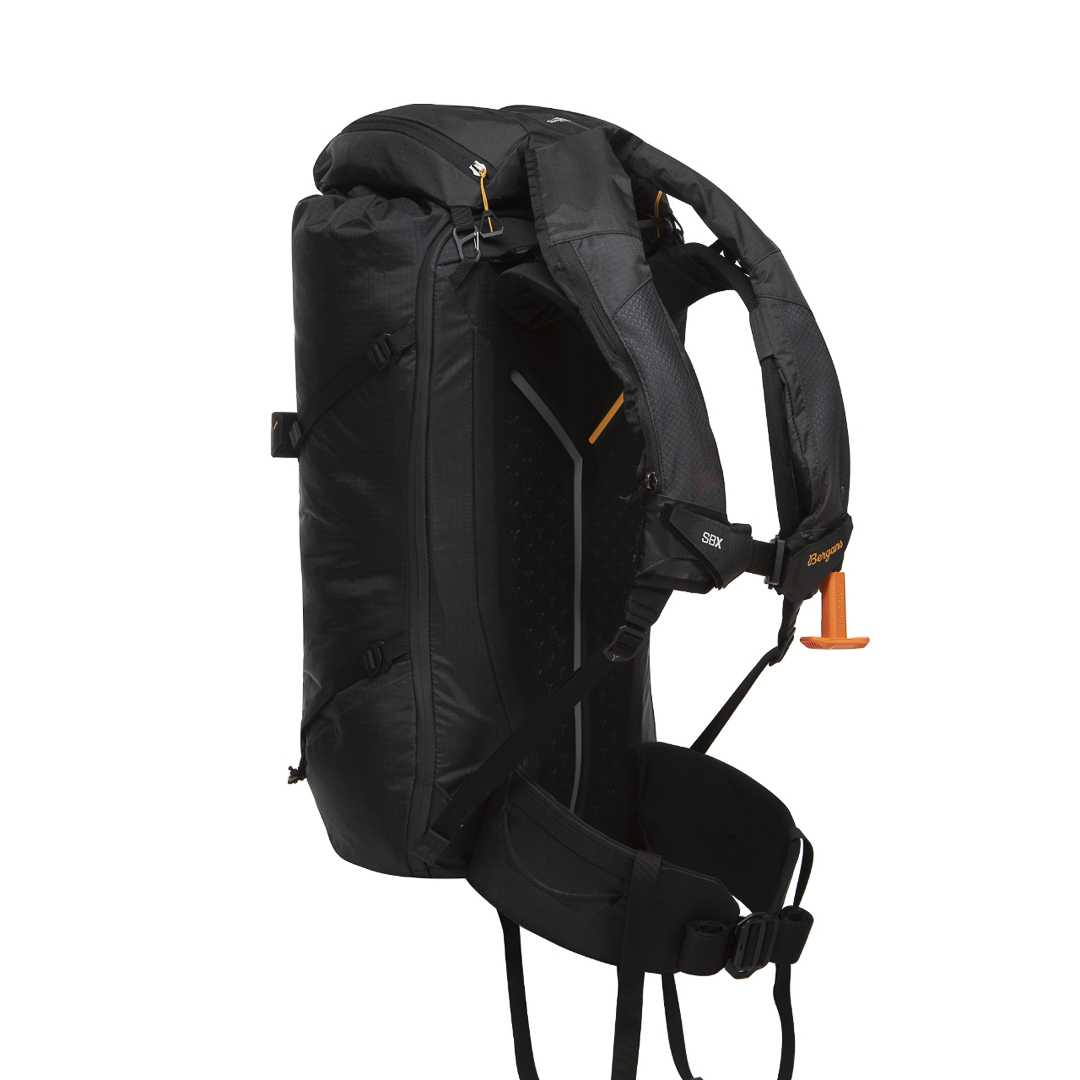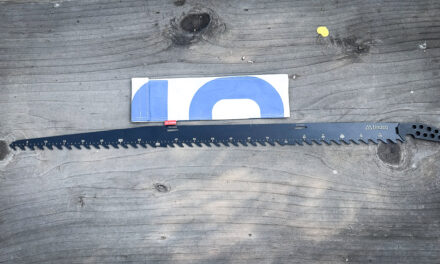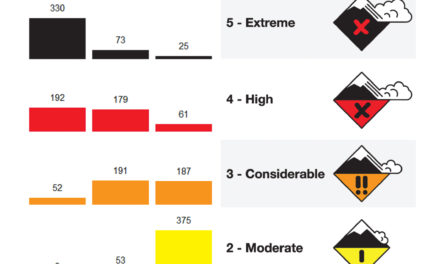Does the world of backcountry skiing need another safety device? A startup from Bergen, Norway, seems to think so.
Since a preliminary presentation of research at the International Committee for Alpine Rescue (ICAR), I’ve heard from colleagues and marketers about this new avalanche safety tool, the Safeback SBX. There is some increasing (and somewhat tenaciously promoted) hype building about this product as it comes to market, and though the thought of debating the addition of another tool to our armamentarium after the airbag pack makes me want to vomit, I think this one worthy of consideration.
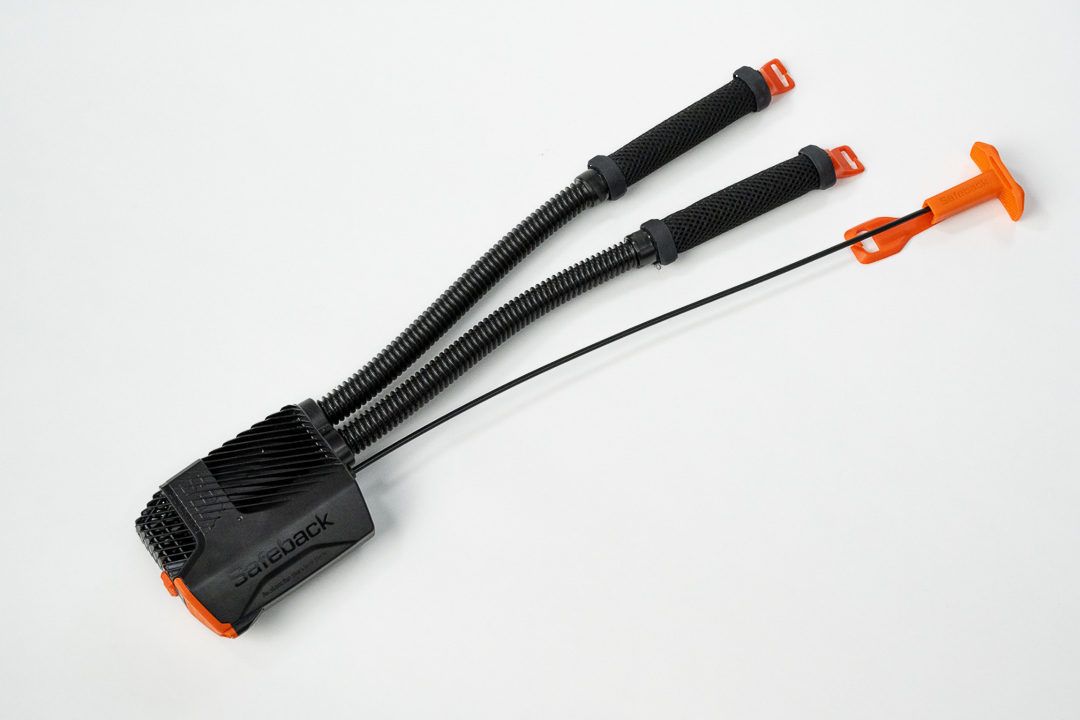
The Safeback SBX system, with air intake/fan module at lower left, with trigger and air outlets at upper right. The system is designed to be integrated into a backpack or vest to prolong survival time by preventing asphyxia after a critical avalanche burial. Photo: Safeback
What is the Safeback SBX? In short, it’s a manually-triggered fan system that can be integrated into a backpack or vest that directs a flow of fresh air around a rider’s face during an avalanche burial. Running on 6 lithium AA batteries, it promises a 90-minute run time and aims to prolong the time a user can be buried before succumbing to asphyxia. The stated weight is 520g, with a volume of 0.75L in the pack’s body. The device is intended to be integrated by manufacturers into new pack designs, already available through Bergans of Norway, but cannot be added as an aftermarket feature to existing packs.
To understand why this tool is worthy of consideration, we should quickly list the ‘avalanche problems’ that could be solved by technology, and the tools that are available for each;
- Identify, and potentially avoid, avalanche terrain: mapping software, apps;
- Reduce the likelihood of triggering an unexpected avalanche in a given location: explosives, cornice cutting tools;
- Reduce the likelihood of burial resulting from avalanche involvement: airbags;
- Reduce the likelihood of trauma resulting from avalanche involvement; helmets, body armor, possibly some airbag configurations;
- Prolong viable burial time after an avalanche: avalung, deflating airbags, Safeback;
- Expedite rescue of a burial victim: avalanche cords, beacons, shovels, probes, dogs, Recco.
It’s striking to consider that most avalanche education for recreationalists focuses on points 1 and 6. First, avoid involvement, but if involved, locate and dig quickly. We know from retrospective studies of avalanche deaths that around 10-15% of those who die in an avalanche die of trauma, and around 75-70% die of asphyxia, or being unable to breathe. The remainder either die of a combination, or very rarely, hypothermia. That makes asphyxia the biggest potential technological target to improve survival for buried victims. It’s therefore quite reasonable for Safeback to pursue this as their goal.
But we should not accept new tools blindly, as they increase the complexity and cost of our skiing and riding lives, and as they can likely influence our behavior, we should be sure that the juice is worth the squeeze.
Below, I’ve created my own Q&A around questions that I had while mentally stress-testing the Safeback concept. To answer some of my questions about the Safeback system, I corresponded with William Sherman, the CMO of Safeback Avalanche Survival Gear. His answers are highlighted in orange.
***
Topic 1: Concept Validity
Question: Has improved airflow been shown to have any effect on buried persons?
Answer: Yes, a peer-reviewed randomized controlled trial published in the journal Resuscitation tested this concept and showed a moderate increase in the time that a person would tolerate burial if provided with supplemental oxygen (13 vs 22 minutes). This isn’t a strong effect and the study wasn’t performed using Safeback systems, but it at least supports the idea.
Question: Avalanche debris is quite dense. Is it possible to create air flow through such a substrate?
Safeback’s Answer: “Based on our field experiments in the full spectrum of snow types, we have observed that porousness is not always directly correlated to snow density. Wet snow tends to be measured as denser, but also has the largest crystal formations that hold larger pores between them. That makes wet snow more permeable than dry snow at the same density. As a result, we have spec’d the system to meet the fan-power requirements of snowpacks that provide the highest resistance to airflow: no-air pocket burials with densely packed dry snow (around 500kg/ m3). System performance improves with increasing porousness, either by increasing crystal size (wet snow) or by decreasing snow density (towards a normal 330 kg / m3).“
Topic 2: Independent Testing of the Safeback SBX System
Question: Has the efficacy of the system been independently tested with live burials?
Answer: Yes and no. A registered clinical trial comparing Safeback SBX to a sham device is ongoing. Preliminary results have been presented in a non-peer-reviewed setting, but a peer-reviewed paper has yet to be published. Eurac research, the group that completed the study, have summarized their work in a nifty multimedia presentation that suggests favorable results, with burial times of at least 40 minutes. Whether the study is valid remains to pass the peer review process, and seeing the research in a print journal will be an important next step.
Question: What relationship did the Safeback company have with the researchers conducting this study?
Safeback’s Answer: “Safeback provided the following to the study: SBX units and Db vests to be tested by researchers, including engineering help to design the “sham” devices that were used as the placebo control in the trial. Eurac’s clinical trial was entirely independently funded by third-party research institutes or academic institutions…Safeback has no financial relationships with [these] institution[s].
“Safeback’s office is in Bergen, Norway, where we were able to pitch our key concepts to mountain medics at the Mountain resulting in an independent partial burial trial in 2019. The positive results of that original trial, published in 2022, eventually led to a full-burial trial to Eurac Research, conducted in March of 2023.“
Topic 3: Comparison to Airbag Systems
Question: How does the weight and volume of SBX compare to a standard BCA airbag?
Answer: The claimed weight of the Safeback system is 520g. The BCA airbag system with a full cannister is around 1700g, determined by the author comparing the Float 32 airbag pack weight to the Stash Pro 32 non-airbag pack.
Question: How does the cost of SBX compare to an airbag system?
Answer: The cost added to the Bergans of Norway backpack currently available is 400 Euro, or $425 by recent conversion rates. The cost of the BCA system, based on the same comparison as above, is $380.
Question: Is SBX potentially more impactful than an airbag?
Safeback’s Answer: “We are not interested in talking down airbags —they are proven safety tools that are effective at reducing the likelihood of burial…While we understand the desire to compare SBX and airbags, most users who are placing their beacon into “send” are buying and using backpacks without safety systems.“
Fink’s Answer: Let’s do a thought experiment. Airbags have been shown to reduce the likelihood of critical burial by 50%. So of 100 buried riders, 50 would not be buried had they been able to deploy an airbag. Safeback can be actuated before riding, removing the potential for a failed trigger. So our 100 riders are buried again, and all 100 of them stay buried, but their air supply is improved. Normally, absolute chance of death increases by about 3% per minute after 15 minutes of burial time. Safeback will have to extend burial time by about 17 minutes to prevent the same number of deaths as the airbags. Can it do it? Preliminary data suggest yes. Hopefully the study will tell us more.
Question: Can Safeback be integrated with an airbag?
Answer: In theory yes, the trigger is designed to potentially dual-actuate an airbag system. This would prevent a user from activating SBX before skiing, and would make the system susceptible to failure to trigger in the same way as an airbag.
Applications
Question: Are there use cases for Safeback that an airbag doesn’t address?
Safeback’s Answer: “For rescuers working at the bottom of an avalanche path under persistent danger of another avalanche, there is little that can reduce the likelihood of burial in case of a second avalanche. SBX helps increase margins of survival for these types of emergency service workers.
“Professionals conducting mitigation of known hazards can activate their system in advance of a ski cut/bomb throw without any physical constraints on their ability to correctly execute a cut or make a throw, while also mitigating the risk of non-activation in case of an avalanche.”
Question: What about protecting against tree well burial / snow immersion?
Safeback’s Answer: “We are also very optimistic about the potential of SBX as a safety tool to mitigate snow immersion.
“While we have been in dialogue with thought leaders in SIS and tree well accidents, there has not been a specific burial test for tree well burials. We have sent our most relevant partner product, the Db Snow Pro Vest, to the Northwest Avalanche Institute for their review in relation to their work with DeepSnowSafety.org. Their review is ongoing. Even without specific testing in tree well snow, our findings from simulated avalanche burial have not suggested that low-density powder snow would in any way reduce air supply from our system.”
Question: Has the device ever been deployed in a real-world burial?
Safeback’s Answer: “No, not to our knowledge. We have not been informed by any customer or partner that they or their customers have been buried with the system this season – neither had any of our professional testers during development.”
Summary
From my perspective, the Safeback SBX system is a potentially impactful technology that could improve the likelihood of avalanche survival and may prolong the window during which companion rescue would be successful. Currently, only the vest version of the technology is available in the US, which to my mind is useful only for mechanized skiing or lift-access use.. The system has some potential uses that airbags can’t address, like activation before performing ski cuts, when at risk during rescue, or to mitigate snow immersion. For now, this is all hypothetical, and both peer-reviewed research as well as real-world testing are needed before I can recommend the technology. Weight, volume, and cost should be competitive, and I hope to test a backpack when they become available.

